|
Subscribe / Renew |
|
|
Contact Us |
|
| ► Subscribe to our Free Weekly Newsletter | |
| home | Welcome, sign in or click here to subscribe. | login |
Architecture & Engineering
| |
March 6, 2002
Tiny Mercer Island chapel solves a small, tricky problem
Special to the Journal
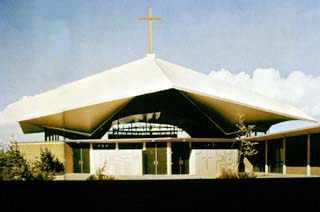
Mercer Island Presbyterian Church, designed by Paul Thiry. |
Mercer Island Presbyterian Church is a landmark high above Island Crest Way, with its hovering tent of a roof and wide open look. A modernist masterpiece by Paul Thiry, the sanctuary takes in distant views and so much natural light that it seems at one with the air and sky.
For prayer, members of the congregation have an alternative to the expansive, outward-looking space in which they gather every week.

Susan Jones |

Steve McConnell |
The new prayer chapel is joined to the sanctuary, yet somehow far away. It enfolds the visitor in a close, meditative embrace, protected from the distractions of the world.
In a corner of the church that was used to store extra chairs, architects Steve McConnell and Susan Jones donated their time to create a precious environment for the prayerful, a secluded space that can be accessed any time the church is open. They worked closely with the Rev. Dale Sewall on the project.
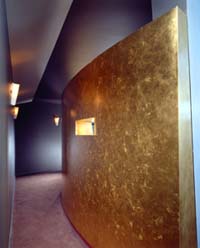
Photos by Steve Keating An opening in the gold-leafed wall allows a glimpse within. |
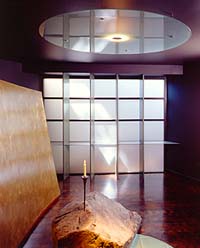
With the translucent screen in the background and focused light from above, the elements of the chapel are clearly arrayed. Within the embrace of the golden arc, the space is set around the "rock of island," the pool of cast glass and the simple candle. |
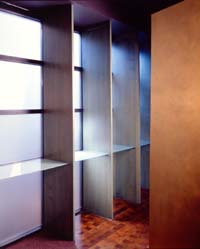
A simple translucent screen with mullions and a shelf serves the mood and the function of the chapel. |
"Sometimes you’re inspired to pray and sometimes life drives you to it," said Sewall. Emphasizing the former, his concept of the prayer chapel is -- a place where you are inspired to pray.
He was impressed by "prayer closets" in Protestant churches in Korea, where people would seek seclusion behind a closed door. While he was inspired by the idea of an intimate space dedicated to prayer, he was also sure that he wanted a place for small groups to gather. The problem for the Mercer Island congregation was simple, according to Sewall: "You didn’t have any place in the church where you could go and pray and be sure that you wouldn’t be interrupted."
In the corner of the landmark sanctuary was a small, hexagonal closet filled with extra chairs. Within this corner, he gave the architects free license to imagine what an intimate space of prayer could be for the Presbyterian church.
McConnell, a principal at NBBJ who specializes in projects for large corporate and institutional clients, is a member of the congregation. He brought in Susan Jones, a partner with NBBJ, who drew from her own experience designing sacred space including the Marian Chapel at St. James Cathedral.
Together with Rev. Sewall, they sought to define the essential elements of an intimate space of prayer, one that is clearly within the Protestant tradition. It would accommodate small groups in addition to individual visitors. And it would place emphasis on the spoken and written word.
One of the first decisions was that the chapel would have no door. The space of the chapel would flow from the sanctuary, but with important elements of transition and separation. Carefully deployed natural and artificial light would support the meditative environment. Focal objects chosen for their ambiguous but universal references to the Christian tradition would anchor the project.
The largest such object is a rock, moved from the grounds during a recent addition and renovation project. Variously named "the Rock of Mercer Island," and the "Rock of Prayer," it appears in early sketches of the chapel. A single candle and a pool of water or light were also singled out as features in the small environment.
The final design began with an arcing wall that would guide a transition into prayer. Reaching into the hexagonal space in a free-standing curve, the arc leads through a short, dark passage toward the light. From the end of the wall, the visitor turns back to the inner space.
Back in the larger sanctuary, the finished chapel appears as a tall, dark opening. Burnished with gold leaf, the arcing wall is articulated at the threshold of the passage. As an invitation and curiosity at the perimeter of the larger space, the entrance links the chapel to traditions much older than the Protestant church.

Sketches by Susan Jones show the concept of the chapel taking shape. |
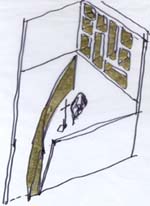
The sketch above answers the question: How do you create a signature effect, yet divide the space? |

This sketch, also by Susan Jones, is a response to her own question: How do you create a center of light coming from above, and also from below? |
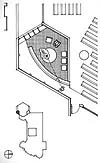
The plan of the prayer chapel shows how a visitor can preview the inner space. |
"The only announcement that the chapel exists is the gold leaf," said McConnell. "There is that aspect of intrigue and mystery."
Just inside the threshold, a sculpted opening in the wall provides a preview of the chapel. Focused on the flame of the candle within, it also serves to give notice of how the chapel is being occupied at any moment, and allows the visitor to make a decision about whether to proceed. From that point, diffused natural light from outer wall -- set with translucent glazing and tall, fin-like mullions -- invites the visitor through the passage.
Three elements fix the attention of the visitor once inside the chapel. A rough-textured rock rises out of the floor from a circular pool of cast-glass tiles. Projecting from the rock, a sculptural forged iron candle stick holds a single candle. The circumference of the tile surface matches another glass circle suspended from the ceiling. A spot of light above that shines down to illuminate the composition on the floor.
A shelf that spans the mullions along the glazed wall holds a book a prayer and a notebook containing requests. Also in keeping with the textual elements of prayer, Bible passages selected by Sewall are lightly stenciled at various points in the passage and on the wall in the chapel. There are some things, like that text on the wall, that might be noticed only on the second or fifth visit to the chapel, he said, and that is by design.
The chapel was dedicated last fall on All Souls’ Day, Nov. 2. As intended, the chapel has become a place to seek out in times of crisis as well as the site of regular meetings for groups within the congregation who engage in what Sewall calls the work of prayer. A large cancer support group fills the chapel after regular Sunday services, and another offers weekly "prayers for the world" based on concerns from the congregation. The chapel is open all day, every day.
Jones and McConnell are both pleased with the mood and an atmosphere they have helped to create for the chapel, and together with Rev. Sewall, they are satisfied that it reflects the restraint of the Protestant tradition. But even the element of restraint spans many religious traditions. The powerful simplicity of design suggests eastern influences.
"One of the (congregation) members ran up an said this is the best Zen-Christian chapel he had ever seen," said McConnell.
| Prayer Chapel Mercer Island Presbyterian Church 3605 84th Ave. S.E. |
|
Mercer Island Presbyterian Church Architects: Steven McConnell and Susan Jones Project type: Interior renovation Completion date: July, 2001 Project size: 330 square feet Project cost: $66,280 Artists: Betsey Eby, gold leaf wall Alec Vassiliadis, forged candle stick General contractor: Crownover Construction Architect of record: Browleight, Peterson, Hanner Jury comments: "This tiny chapel manages to balance the need for an introspective space with it’s own architectural identity and symbolism, without compromising the architectural integrity of the original church. I especially appreciate the attention to the wall finish, which introduces the chapel in a deliberate but graceful way." "This seems to be the perfect solution to a small tricky problem. The tactile and well-crafted chapel fits nicely into the enveloping mass of its mother ship, a historic church designed by Paul Thiry." "A simple space where the few spare elements work to create progression, enclosure and serenity. This is not a major work, but everything in it works together to achieve its meditative goal." "This spare, well-crafted space -- carefully inserted into a Northwest icon building -- conveys a sense of peace and contemplation, masterfully executed." |
Clair Enlow can be reached by e-mail at clair@clairenlow.com.
Previous columns:
- Temporary library makes a lasting impression, 02-06-2002
- Signature identity on a human scale, 01-09-2002
- Gates Hall uses the past to create a better future, 12-05-2001
- A study in flexibility, 11-07-2001
- Southeast Tower cures several ills at Swedish, 10-03-2001
- Growing Vine Street takes root at 81 Vine, 09-05-2001
- A new model for affordable housing, 08-01-2001
- Swimming in good architecture, 07-05-2001


